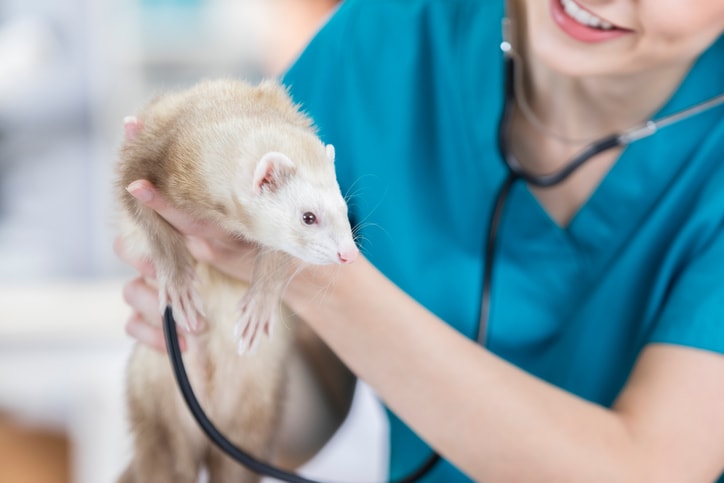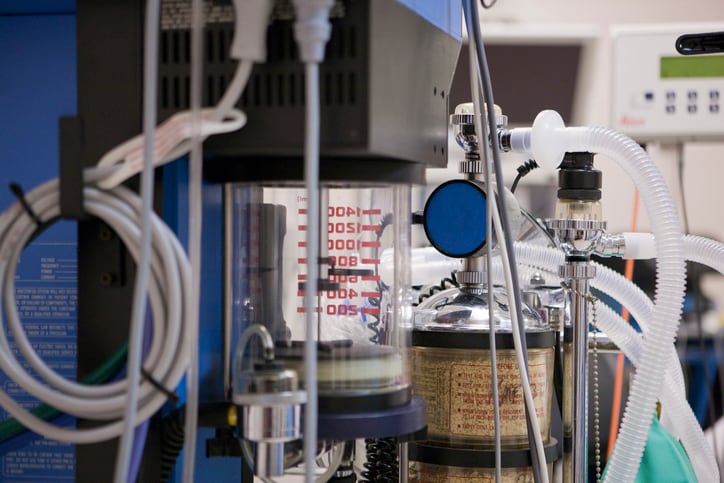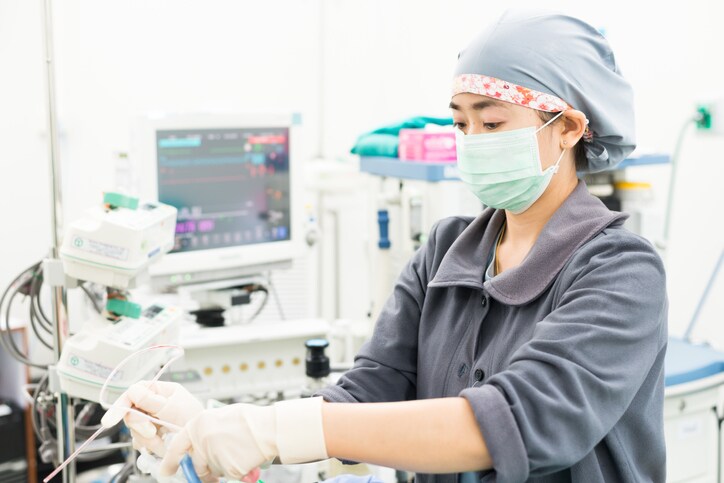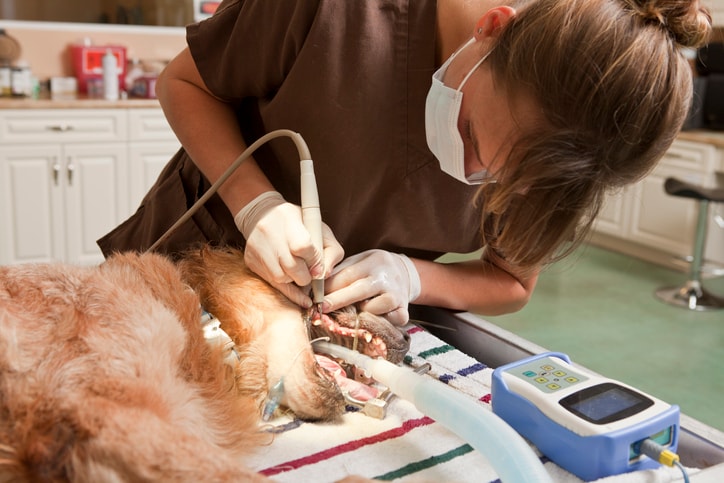Dental procedures are performed routinely within veterinary general practices each day, but they are far from routine procedures. Due consideration to the health status and risk factors of the patient should be given on an individual basis to ensure a safe anaesthetic event and successful outcome for each patient. Often, these patients are at an increased anaesthetic risk simply because of a co-existing disease state with periodontal disease (itself a disease state of chronic inflammation) and increased risk factors due to age, breeding, weight and health status. These risks can be mitigated through careful planning, preparation for all emergent events and vigilant monitoring of the anaesthetised patient.
A UK study performed in 2006 over a two-year period, involving more than 185,000 dogs, cats and rabbits was carried out to:1
- estimate the species-specific risks of anaesthetic-related death in small animals in the UK;
- identify risk factors for anaesthetic-related death; and
- formulate recommendations to improve the practice of small animal veterinary anaesthesia.
The study found:
- The risk of anaesthetic-related death in dogs was 0.17%, in cats was 0.24% and 1.39% in rabbits (on average)
- The risks increased in animals with poor health status, extremes in age and weight, and the complexity or duration of the procedures performed
- The risks decreased with pre-operative blood testing, familiarity with the anaesthetic used, and vigilant patient monitoring.
The study also highlighted the procedures that an anaesthetic-related death most commonly occurred and Dental Procedures appeared high on that list for both cats and dogs.
A patient undergoing a dental procedure is at a greater anaesthetic risk for a number of reasons:
- Age – many of our dental patients are older and likely to have co-existing disease processes occurring. These older animals are more likely to be less able to compensate for hypothermia and hypotension.
- Systemic disease – in human health there appears a correlation between periodontal disease and some systemic disease processes – we can assume the same correlation may apply with our veterinary patients
- Increased anaesthetic depth – pain assessment and perioperative analgesia affords the use of lesser volatile gases
- Extended anaesthetic length – dental procedures can be amongst the longest anaesthetic procedures
- Hypothermia – Can have grave consequences. It affects metabolism, blood viscosity, cardiovascular function and dose of drugs required. It can also lead to delayed healing and increased risk of infection.
- Iatrogenic injury – anaesthetic events are complicated, and mistakes can be made that injure a patient. Taking steps before, during and after an anaesthetic can prevent injury.
Of particular consideration with patients undergoing dental procedures, is providing them a stable anaesthetic event. A thorough and ongoing pain assessment throughout their procedure and providing adequate and effective analgesia is of the utmost importance – even more so in the compromised patient as the stress of pain results in decompensation during the procedure, during recovery, or in the days immediately after the procedure.2 Some of these patients have been living in a state of chronic pain and may even be hypersensitive to any stimulation. The use of regional nerve blocks has been shown to allow a reduction in inhalant anaesthetic gases by as much as 23%.3
Minimising heat loss to prevent hypothermia is significant for these patients. The use of vasodilatory premedicants and anaesthetic drugs, cold inhalant gases and intravenous fluids, along with water-cooled instruments in a cold environment and extended anaesthetic times can lead to significant heat loss. Treatment begins with Prevention – Actively warming these patients perioperatively and vigilantly monitoring their body temperature can help minimise this condition.
Adequately preparing for a patient’s anaesthetic procedure can help reduce anaesthetic risks. A thorough health examination with pre-operative diagnostics provides us with an accurate picture of the patient’s health status. An appropriate Anaesthetic and Analgesic Plan can then be made based on the individual’s needs. For the Veterinary Nurse, this is an opportunity for us to discuss all possible scenarios with our veterinary surgeon to anticipate and prepare for all eventualities throughout the procedure.

Often this health examination reveals the existence of another disease or condition in our dental patient. The term “comorbidity” describes two or more disorders or illnesses occurring in the same patient, either at the same time or one after the other. It also implies interactions between the illnesses, that can worsen each condition, or both. Common co-existing disease found in our dental patients can include:
- Cardiovascular disease
- Respiratory Disease (eg Brachycephalic Obstructive Airway Syndrome)
- Endocrine Disease (eg Cushings, Diabetes Mellitus, Hyperthyroidism)
- Renal Disease
And other risk factors relating to:
- Obesity
- Age – either paediatric or more commonly geriatric
The keys to success for any anaesthetic event lie in the knowledge and preparedness of the veterinary team, the reliability of the anaesthetic equipment, and diligent monitoring throughout the entire event.2
Anaesthetic management of the dental patient with co-morbidities involves:
- An understanding of the disease processes &/or risk factors and their effects on the patient’s ability to cope with a general anaesthetic;
- Your veterinary surgeon’s choice of premedicant and anaesthetic drugs based on the data gathered during the health examination and pre-anaesthetic diagnostic assessment
- Vigilant patient monitoring throughout the procedure and into the Recovery phase
- Preparedness in the event of an anaesthetic complication occurring
- Pain Management
- Nursing considerations for the post-operative comfort of the patient and their long-term health.
- Nursing considerations for the post-operative comfort of the patient and their long-term health.
In 2019, the American Animal Hospital Association (AAHA) released the AAHA Dental Care Guidelines for Dogs and Cats.4 The Guidelines outline a comprehensive approach in improving the oral health and quality of life of canine and feline patients. They cover topics from oral health assessment and the dental cleaning to recommendations on general anaesthesia, pain management, and equipment along with client education and preventative oral healthcare. Within the Guidelines (and available on their website) they discuss the topic of Iatrogenic Anaesthetic Injuries and the steps that Veterinary Teams can take to prevent these common injuries to patients.4
Pulmonary Barotrauma
- Inadvertently forgetting to open the “Pop-off” Valve; improper use of the O2 Flush valve; aggressive ventilator settings, or outflow restriction/obstruction. In as little as 30 seconds, pressure within the anaesthetic system can cause damage to a cat’s airway. With increased time, lungs can rupture and collapse, hypoxic brain damage can occur, followed by death.
- Prevention: High-pressure alarm and an Attentive Team – Nothing is a substitute for a dedicated individual monitoring the anaesthesia.

Blindness
- The use of spring-loaded mouth gags in cats is a risk factor for cerebral ischemia. When a cat’s mouth is fully opened, a reduction in blood flow to the retinae and the brain can occur.
- Prevention: Prop mouth open no more than 2-3cms – a lap sponge placed between the premolars is adequate to prop the mouth. Dental mirrors help with visualisation.
Tracheal Tears
- Over-inflating ET Tubes can cause the remarkably fragile airway to tear.
- Prevention: Avoid the Intrathoracic Trachea and Handle with Care – premeasure ET Tubes, lubricate the cuff, inflate to a pressure of 16-18cmH2O. Handle the patient with care when moving ensuring patient is disconnected prior to any movement.
Airway Occlusion
- The ET Tube can kink and occlude airflow during repositioning of the patient
- Prevention: Disconnect ET Tube – disconnect the ET Tube before repositioning the patient – avoid flexion of the neck – remember to reconnect the patient!

Aspiration
- Dental patients are at an increased risk of aspiration, not only from regurgitation of stomach contents, but the water, debris, blood, saliva and solution used during the procedure.
- Prevention: Vigilant Airway Management – Fasting in preparation of the procedure, cuffed ET Tube and pharyngeal pack along with “legs under” when repositioning the patient.
Thermal Burns
- Inappropriate heat support can cause thermal burns in the anaesthetised patient.
- Prevention: Use Medical-Grade warming systems – choose safe, active-warming approaches and avoid warming equipment not manufactured specifically for companion animal use.
In conclusion, the Dental patient can present the veterinary team as a challenging patient. Not only in the proper diagnosis and treatment of oral disease and pathologies, but in the safe management of their general anaesthetic and recovery. There is no substitute for an Anaesthetic & Analgesic Plan taking into consideration the individual patient’s needs, a prepared veterinary team for all eventualities and vigilant patient monitoring.

Maggie Burley – RVN, AVN, Cert IV VN, Dip VN (Dentistry), VTS (Dentistry)
For more than 10 years Maggie has worked in small animal general practice and became focussed on dentistry after seeing many pets in obvious pain and discomfort due to oral health problems, she finds it highly rewarding to see the improvement in a pet’s life following effective and appropriate dental treatment.
Her passion for dentistry has led to her obtaining the Diploma of Veterinary Nursing (Dentistry), and the VTS in Dentistry – the first & only in Australia. She has studied under Veterinary Dental Specialists both in Australia and the United States and attended many dentistry focused conferences & workshops. Her hope is that veterinary dentistry continues to grow and that a good oral hygiene routine becomes a normal part of every pet’s daily life.
- Brodbelt DC, Blissitt KJ, Hammond RA et al. The risk of death: the confidential enquiry into perioperative small animal fatalities, Vet Anaesth Analg, 2008;35(5):365-373.
- Perrone JR, editor. Small animal dental procedures for veterinary technicians and nurses. 1st edn. Wiley-Blackwell, Iowa, 2013.
- Snyder CJ, Soukup JW. Oral and maxillofacial disorders. In: Snyder LB, Johnson RA, editors. Canine and feline anaesthesia and co-existing disease. 1st edn. Wiley-Blackwell, Iowa, 2015:187-202.
- Bellows J, Berg ML, Dennis S et al. (2019) 2019 AAHA Dental Care Guidelines for Dogs and Cats. JAAHA, 2019;55(2):49-69.
